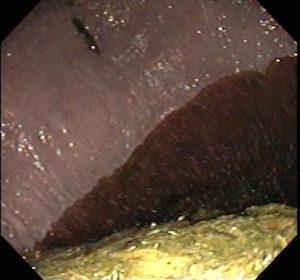Ways to Prevent and Treat a Debilitating Problem
by Wendy Mollat, DVM, DACVIM
Research studies estimate that 60% to 90% of performance horses have gastric (stomach) ulcers. Horses with gastric ulcers can present in a variety of ways: weight loss/hard keeper, poor hair coat, behavioral issues, mild colic, poor appetite and poor performance. Stomach ulcers are the result of multiple factors including infrequent feeding, prolonged travel, use of non-steroidal anti-inflammatory (NSAID) medications and intense exercise.
It is notable that horses secrete stomach acid 24 hours per day. From an evolutionary standpoint, this makes sense as they are designed to graze continuously which leads to direct buffering of the acid by feed material and bicarbonate-rich saliva. Unfortunately, equine management today often results in horses only eating two or three meals per day, putting them at significant risk for developing gastric ulcers. The good news is that such ulcers are easily diagnosed with gastroscopy and are usually very treatable with medication. The bad news is that the treatment course is prolonged (30 to 60 days) and expensive ($800 to $1,000 per month). In light of that, prevention becomes very appealing!
Decreasing the risk of your horse developing stomach ulcers only requires a little forethought and some adjustments in your daily management routine. Begin by mimicking a horse’s natural feeding environment. Horses that predominantly graze for their food have a very low incidence of gastric ulcers. Increasing time at pasture is the ideal answer, but not always attainable. Alternatively, feeding smaller meals more frequently or using a slow-feeding system can help to better simulate the natural environment.


Another option is to add alfalfa hay. Alfalfa has higher levels of calcium and protein. Calcium is a major component of antacid medications. Research has shown that horses on alfalfa hay have a lesser degree of gastric ulcers compared to their cohorts on grass hay. Even replacing 25% of your horse’s grass hay with alfalfa may provide some protection from ulcer formation. For ulcer prevention, it is best to spread the total volume of alfalfa fed over the day (e.g., feed ¼ flake three to four times per day vs. 1 flake once daily). Remember, however, that alfalfa is higher in calories and nutrient density so, as with all diet changes go slowly and monitor your horse’s body condition to ensure he does not gain too much weight. Also, limit the amount of starch in the diet and always feed hay before you feed grain. Higher starch feeds like sweet feeds result in higher levels of volatile fatty acids, which can damage the stomach lining much like gastric acid. Horses also produce less saliva when they eat grains. For horses at higher risk of gastric ulcers, I recommend choosing a concentrate product that is higher in fat and lower in starches and sugars to minimize this effect.
To help prevent ulcers, don’t exercise your horse on a completely empty stomach. This is counterintuitive to many of us. I am not advocating feeding a large meal before you get on for a big workout, but offer ¼ to ½ flake of hay (preferably alfalfa) 30 minutes before you ride. Intense exercise has been shown to decrease the size of the stomach and increase acid production; both of these factors lead to an increased risk of gastric ulcers. In addition, use NSAIDs judiciously. It is well documented that the use of medications like Banamine or Bute can cause gastric and colonic ulcerations due to alterations in prostaglandin levels and GI mucosal blood flow. Intermittent doses are perfectly safe for most horses, but be sure to consult with your veterinarian before using either of these medications for more than a few days in a row.
Maintaining your horse’s routine is also key. Use preventative medications during times of extended travel, transport or shows. Research has shown that horses can form significant gastric ulcers in as little as four days when transported out of their normal environments. Taking your own feed and using preventative products such as UlcerGard can help keep your equine friends performing at their best and reduce the risk of them developing ulcers while on the road.
Diagnosis and Treatment
If you do suspect your horse has gastric ulcers, they can be easily diagnosed using gastroscopy. Currently in the United States, there is one product licensed for the treatment of gastric ulcers (GastroGard) and one labeled for the prevention of gastric ulcers (UlcerGard). Recently, more research has been focused on investigating the effectiveness of certain digestive supplements in helping to prevent gastric ulcer formation. It appears that these digestive aides may help to prevent the reformation of ulcers post-treatment with GastroGard. We’ll keep you posted on that.
HighlightDr. Wendy Harless Mollat leads the equine referral hospital at Pilchuck Veterinary Hospital, Snohomish, Washington (pilchuckvet.com). Her areas of focus include bio-security, neurological diseases, neonatology, equine gastric ulcer syndrome, and camelid (alpaca and llama) medicine. Reach Pilchuck’s equine department and 24/7 emergency service at 360.568.3111.
Originally Published July 2014 Issue
Board-Certified Internal Medicine Specialist, Large Animal Pilchuck Veterinary Hospital. Dr. Wendy Harless Mollat grew up in Bend, Oregon, where she was actively involved in riding and training hunter/jumper and dressage horses. She graduated with her DVM from Oregon State University in 2002 and went on to complete a one-year internship in equine medicine and surgery at Pilchuck. Dr. Mollat followed her internship with a three-year residency in large-animal medicine at UC Davis and became board-certified by the American College of Veterinary Internal Medicine. In September 2006, Dr. Mollat returned to Pilchuck, where she now leads the equine referral hospital. Her areas of focus include biosecurity, neurological diseases, neonatology, equine gastric ulcer syndrome, and camelid (alpaca and llama) medicine.






